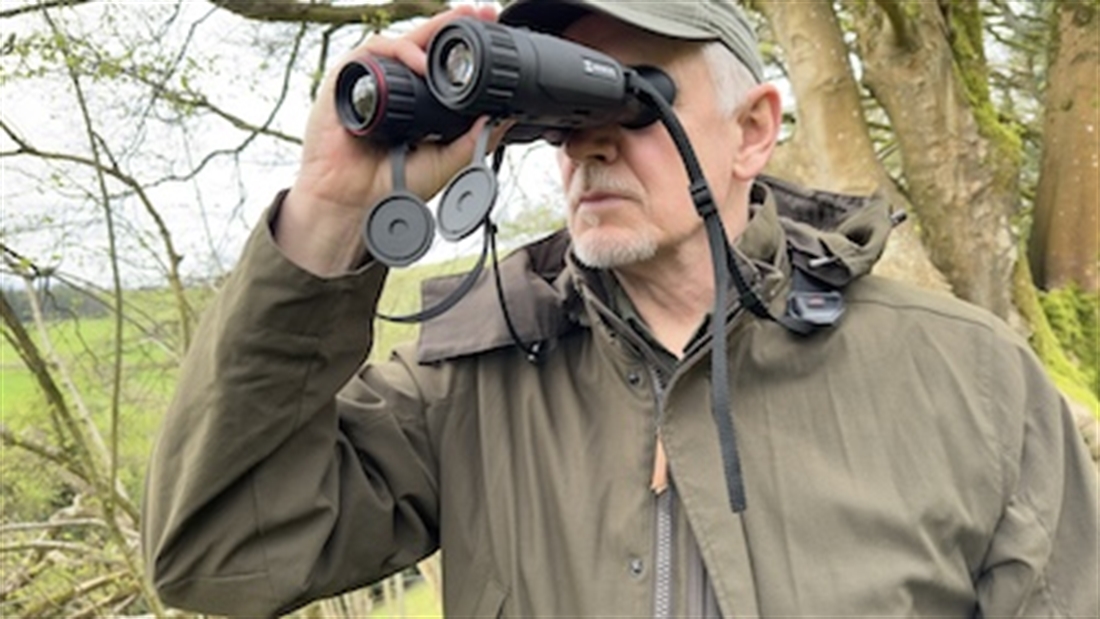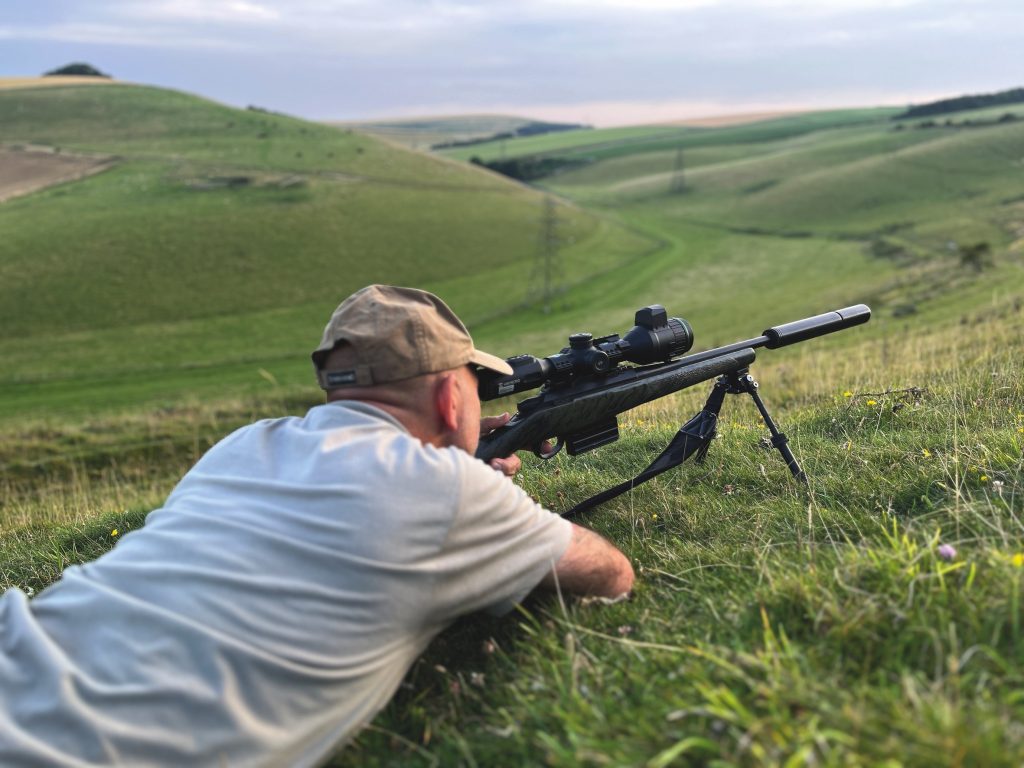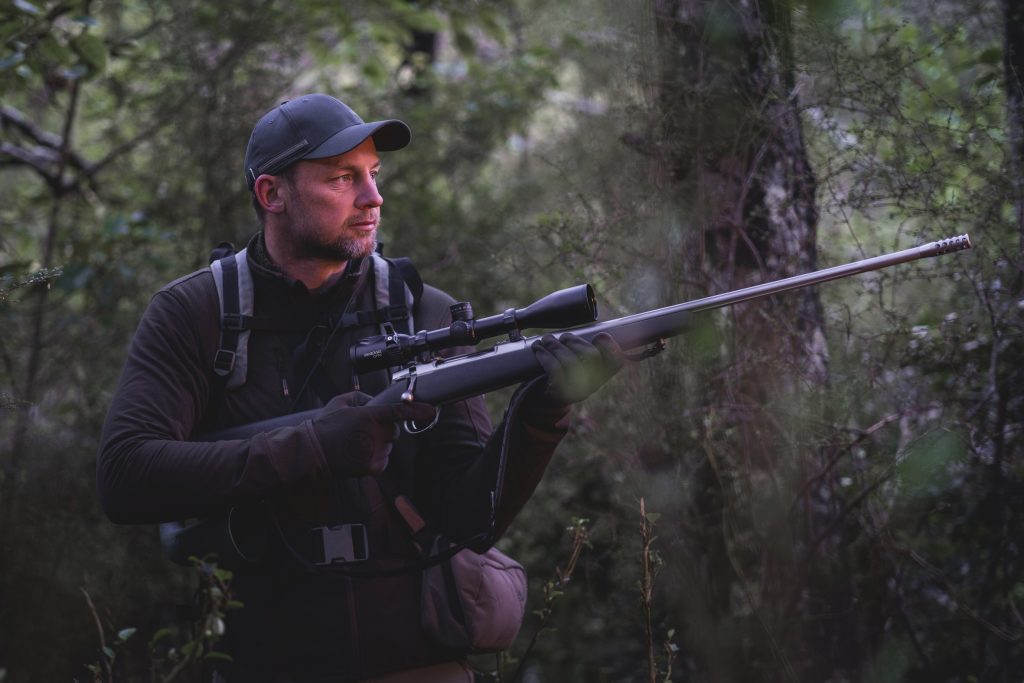HikMicro Habrok HQ35L multi-spectrum LRF binoculars
Paul Austin takes a long and admiring look at a multi-spectral spotting solution that set’s a new standard for what we can expect from a day/night spotter

It’s been a long wait but the Habrok finally arrived, alongside the highly anticipated Alpex LRF 4K day/night digiscope – which you’ll also find in this issue. The first job, charge up two of the four 18650 batteries which ship with the device for an initial test.
The charge lights finally flipped to green, and I was good to go. With the batteries popped into separate compartments below each barrel I powered up and started scanning the house and fiddling with the functions. Indoors the thermal image was exceptional, with smooth gradients and sharp details.
After mastering the basics regarding the buttons and menus I was out in the garden, scanning across the valley and tinkering with the settings. Oddly the thermal image was OK but not outstanding. The internal display is huge, I assumed that Hik may have simply over-stretched the abilities of their 640 sensor? It was all a bit rough around edges and slightly flat.
I tinkered with colour modes, brightness and contrast, switched detection types, but ‘OK’ was as good as it got, pretty good… but frankly mildly disappointing. This went on for about a week, so I called Mark Ripley who’d had a pair for a while. He was very happy with the image quality, stating that he thought it was… “up there with the very best”. Mark does like the higher contrast of the Hik and iRay thermals, whereas I generally lean more towards the balanced image of Pulsar thermals.
Personal preferences aside, this didn’t add up? Finally, the penny dropped, or perhaps more importantly the weather improved. This has been (for me a least) the wettest winter in living memory. Wales is famously moist, but it’s been ridiculously wet. When that improved so did the thermal image quality of the Habrok. Drier air transformed this device from OK to outstanding.
All thermals suffer in wet/damp conditions and the Habrok is no exception. However, very few offer the feature set, ease of use, affordability and functionality of this device. For most of us the thermal function is the primary feature but that’s only the tip of the iceberg with daytime optical, LRF and IR modes also available. However, before we get to the functionality let’s talk about the feel and ergonomics of the thing.
First impressions
Firstly, they’re a lot lighter than I initially expected, even fully loaded with 18650’s, weighing in at 780 grams. I didn’t have any issues with stiffness in the shoulders or any upper back pain after using them for hours on end.
The array of six chunky buttons fall nicely to the fingers, best of all their chunkiness means no fumbling in the dark trying to find a function. I won’t bore you with all the functions, in short, it has everything you’d expect from a high end thermal and more.
There’s an impressive selection of colour modes plus the option to switch off those you don’t like or seldom use. I defaulted to white hot, black hot and optical fairly quickly. The eye pieces are slidable to set the correct ocular distance and each eye is separately focusable.
At the end of each barrel we have the focusing, left for the optical (IR daytime), right for the thermal. All the controls are smooth and simple, and although there’s a lot of functionality to play with all the various adjusters and buttons work well with key functions like zoom and LRF triggering falling directly under your index fingers. The left-hand buttons control the LRF, video/pics and power/standby, while the right handles zoom, main menu access and mode switching – daytime, IR and thermal.
There’s an excellent PIP function which allows you to mix of thermal and IR/optical on-screen simultaneously, which when combined with the zoom function makes detecting and IDing in one hit very straightforward. And obviously you can easily toggle between which feed you prefer (thermal/IR or optical) in the main screen and the PIP window.
The LRF just about made the claimed 1000m after multiple pings, but it was very reliable up to the 850m mark. More importantly it was accurate when tested against my traditional LRF binos.
Switching modes is simple enough with the top right button flipping between the selected thermal palettes and optical/IR. A long press toggles between the daytime/IR optical settings split into day, twilight and full NV, with the final two triggering the built in IR torch which offers multiple power levels plus a smart mode. I left it on smart mode, and it performed perfectly.
The daytime optical is obviously digital, there’s no mistaking that. It doesn’t offer the clarity of traditional binos but it’s more than sufficient for IDing quarry at extreme range and works really well in low light conditions. I’d have no qualms employing it to sex deer or judge their condition at last light. That’s not something I could say for a traditional thermal spotter.
In the field
Now we get to the crunch, how did it perform? At first, I had a few issues with battery life. I was getting 2-2.5 hours until I realised that you need to turn off the IR manually. I was flipping modes but not switching back into optical which left the IR on permanently and hammered the batteries. After spotting that user error I was achieving 3.5 to 4 hours, and that’s with near constant observation and mode switching while covering the lambing fields. In a typical daytime/evening/nightime ‘walk and stalk’ scenario (using standby) that could easily be stretched to the 6 hours claimed in the marketing bumph and manual.
I can’t overstate the importance of having IR and thermal combined. Throw LRF into the mix and you have an exceptional range of tools at your disposal. This device, and others like it, finally make a fully thermal scope and spotter combo a viable option.
You don’t need IR mode in most situations but when you do… you really do! If an animal is moving, it’s pretty easy to ID it at typical ranges but increase that range or if you spot ‘something’ sat in a field full of sheep it’s a very different story and that’s where the IR option comes into its own.
A possible fox turned out to be a large farm cat mooching for mice at 280m. An easy spot using the thermal, but it was the IR that easily confirmed exactly what I was looking at. The illuminator was surprisingly good, offering excellent image quality out to 150m which remained perfectly useable out to 250/300m and maybe even further – even on smaller game.
During a full-moon I was IDing sheep at 540m easily. Obviously, the IR wasn’t reaching that far but the combination of IR, moonlight and the Harbok’s exceptionally good IR sensor really came together. The IR is also focusable, so you can stretch it out a long way.
Any issues?
Is it perfect? No, let’s face it what product is. However, it’s easily the best multi-spectral solution I’ve seen to date. There are a couple of bugs. The LRF readout is small and squeezed into the very top right-hand corner of the screen, so you have to squint into the corner of the screen to see it, which inevitably takes your eye off what you’re trying to range. Hopefully an easy firmware fix. It would be much better centred either at the top or bottom of the screen.
The IR, although surprisingly powerful, isn’t aligned perfectly. Focus in and it creeps up the screen and when tightly focused only covers the top half of the image. If you then zoom in it gets cropped out and at full mag it’s almost none existent. It remains usable at 14x but that’s about it.
I’d also prefer a base mag of 2 or 2.5x rather than 3.5 – which translates into 7x, 14x and a rather silly 28x – as you apply the fix zoom settings. A max mag of 16x or 20x would better in my opinion.
The bottom line
These ‘issues’ are mildly annoying rather than deal breakers for me. This is an exceptional device. The combination of features, performance, ergonomics, and let’s not forget price put it in a league of its own. The combination of thermal, IR, daytime optical and LRF are really well implemented overall.
Often these ‘do-it-all’ devices leave something to be desired in one area or another but not in this case. I would definitely recommend saving up the extra £600 for the 640 variant, as I’m pretty sure the huge display wouldn’t do a 384 sensor any favours. The Habrok is not perfect but it’s pretty close and comes in at a price that will reshape what we can expect to pay and the level of performance we can expect. Highly recommended.
Tech specs
640×512 12 micron sensor
Sub 20mK NETD sensitivity
F1.0 35mm High Performance Lens
Magnification 3x to 24x with Zoom Pro
Field Of View- 12.5 x 10.1 deg
1000m Laser Rangefinder
1920×1080 HD display
Pictures, video recording with Wifi
App connectivity
Optical Camera
2560x1440px Progressive Scan CMOS Image Sensor
Optical Magnification range 2.9x to 23.2x (with digital zoom)
Field of View 13.9×7.8 deg
Smart IR illuminator built in
Supplier: Scott Country International
Web: www.scottcountry.co.uk
Price: £2799.99
Related Articles
Get the latest news delivered direct to your door
Subscribe to Rifle Shooter
Elevate your shooting experience with a subscription to Rifle Shooter magazine, the UK’s premier publication for dedicated rifle enthusiasts.
Whether you’re a seasoned shot or new to the sport, Rifle Shooter delivers expert insights, in-depth gear reviews and invaluable techniques to enhance your skills. Each bi-monthly issue brings you the latest in deer stalking, foxing, long-range shooting, and international hunting adventures, all crafted by leading experts from Britain and around the world.
By subscribing, you’ll not only save on the retail price but also gain exclusive access to £2 million Public Liability Insurance, covering recreational and professional use of shotguns, rifles, and airguns.
Don’t miss out on the opportunity to join a community of passionate shooters and stay at the forefront of rifle technology and technique.




